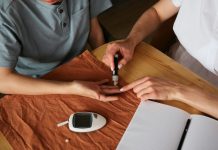
For people living with diabetes, keeping an eye on blood sugar levels is a crucial part of daily life. It helps in managing their condition and preventing complications.
Today, there are several methods available for monitoring blood sugar, ranging from traditional finger pricks to advanced continuous monitoring devices.
This article provides an overview of these techniques, explained in plain language, so that anyone can understand the options and how they work.
Traditionally, the most common method to check blood sugar has been the blood glucose meter, which requires a small blood sample usually obtained from a finger prick.
This method involves placing a drop of blood on a test strip inserted into the glucose meter, which then gives a reading of the current blood sugar level.
This technique is effective and gives accurate results, allowing for immediate decisions on managing blood sugar. However, it can be uncomfortable due to the need for frequent finger pricks, which can be a deterrent for consistent monitoring.
To address some of these challenges, newer technologies have been developed, such as continuous glucose monitors (CGMs). CGMs provide a more comprehensive picture of blood sugar trends throughout the day without the need for constant finger pricking.
A CGM consists of a tiny sensor inserted under the skin, usually on the abdomen or arm, which measures glucose levels in the tissue fluid. This sensor sends information to a display device or a smartphone, showing real-time data and trends in glucose levels.
This method can alert users to sudden changes in their blood sugar levels, which can be particularly useful for avoiding dangerously low or high levels.
Another innovative approach is the flash glucose monitoring system, similar to CGMs but requires the user to scan the sensor to get glucose readings instead of providing continuous real-time updates.
This system also involves a sensor placed on the body, and when a device is scanned over it, the current blood sugar level and the last eight hours of data are displayed.
This method reduces the disruption and discomfort of routine finger pricks while still offering detailed information on blood sugar patterns.
Research has shown that both CGMs and flash glucose monitors can lead to better blood sugar control compared to traditional monitoring, especially for individuals with type 1 diabetes.
Improved control is linked to a reduced risk of diabetes-related complications. Studies have also highlighted the psychological benefits of using CGMs, including reduced anxiety over blood sugar levels and improved quality of life.
Despite their benefits, these advanced monitoring techniques can be more expensive than traditional methods. They also require some training to use effectively.
However, many health insurance plans are beginning to cover these devices, recognizing the long-term benefits they offer in managing diabetes and preventing costly complications.
The choice of monitoring technique depends on several factors, including the type of diabetes, lifestyle, personal preferences, and financial considerations.
While traditional blood glucose meters are cheaper and sufficient for many, devices like CGMs offer significant advantages in terms of convenience and depth of information.
In conclusion, modern advancements in blood sugar monitoring technology provide valuable tools for individuals managing diabetes.
From traditional finger-prick tests to continuous and flash glucose monitors, these methods offer various options tailored to meet different needs and preferences.
As technology continues to evolve, these tools become more accessible and easier to use, promising better management of diabetes and an improved quality of life for those affected.
If you care about diabetes, please read studies about Vitamin D and type 2 diabetes, and to people with diabetes, some fruits are better than others.
For more information about diabetes, please see recent studies that low calorie diets may help reverse diabetes, and 5 vitamins that may prevent complication in diabetes.
Copyright © 2024 Knowridge Science Report. All rights reserved.



